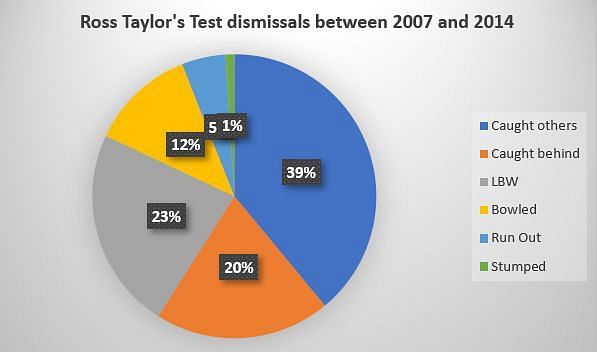
New Zealand's Ross Taylor searches for perfection through his imperfections

In the late 2000s and the early 2010s, not many New Zealand batters made as much of an impression as Ross Taylor. Even at that juncture, the right-hander, despite enduring a teething period in international cricket, was heralded and projected as one of New Zealand’s leading lights.
To Taylor’s credit, he has largely repaid the faith New Zealand placed in him a decade earlier, meaning that the batter, at this point, represents one of the Kiwis’ most crucial all-format players. In fact, it wouldn’t be far-fetched to suggest that he is also one of the best batters New Zealand have ever produced.
To place things into context, Ross Taylor averages 45.55 in Test cricket, having accumulated 7426 runs across 106 matches. In ODIs, the numbers are even more staggering – an average of 48.20 corresponds to 8581 runs. As far as T20Is are concerned, the statistics aren’t as astonishing but a return of 1909 runs at 26.15 isn’t too shabby either.
However, for someone who has enjoyed unparalleled success, there are still a few damning deficiencies in the New Zealand batter’s closet.
Taylor and New Zealand are preparing for the WTC Final
Though he has somehow almost always found a way to tide over those, there is one particular weakness, namely his tendency to fall over off stump, that is threatening to mar a defining moment in his cricketing sojourn.
Not just because it could be his lasting image, considering he is in the twilight of his cricketing journey, but also because it has crept along just before one of the biggest flagship events of his career – the World Test Championship final.

Over the past couple of years, Taylor’s batting in Tests has plateaued a little, both in terms of the sheer weight of runs and the manner in which he has gotten them.
Since the start of 2020, the New Zealand cricketer has managed only 269 runs in 12 Test innings. During that period, he has failed to cross the hundred-run mark and has only passed fifty once (against Pakistan at Mount Maunganui in December 2020).
Thus, there is enough to suggest that the runs have dried up. While he has only been dismissed twice LBW in the aforementioned phase, he has often fallen across his stumps – something that recently came to the fore against England at Lord’s.
Between November 2007 (Taylor’s Test debut for New Zealand) and 31st December 2014, the New Zealand batter was dismissed LBW 23 times. In total, he was dismissed on 100 occasions, meaning that the percentage stood at a worrying 23%.

Since the start of 2015, there has been a slight improvement, although Taylor is still prone to getting out LBW. Overall, between 2015 and 2021, the New Zealand batter has been accounted for on 63 instances. Out of those, the LBW has been his kryptonite 13 times. When compared with his earlier stats though, the corresponding percentage of 20.63 doesn’t seem as shoddy.
Yet, when looking at his career throughout, there is enough to suggest that Taylor always seems just a good delivery away from being an LBW candidate. And a lot of it could be explained by the way he sets up.
For quite a while, the New Zealand cricketer has been deemed someone who prioritized the on-side for run-scoring. In white-ball cricket and especially the IPL (largely for RCB), people still have vivid memories of Taylor shuffling across his stumps and biffing the ball over cow corner regularly.
Hence, there has been a proclivity from Taylor’s end to get into positions that help him target the leg-side consistently. In turn, though, it has also led to him getting trapped in situations where accessing deliveries on middle and off stump has become incredibly tedious. His early trigger across his stumps hasn’t really helped.
Against England at Lord’s, that propensity was exploited by Ollie Robinson, in particular. For large swathes of his spell, the pacer resorted to dangling the carrot outside off stump before decking the ball into Taylor from a similar line.
Unsurprisingly, Taylor’s head fell across and he had to play around his front pad. Though he managed to get away a couple of times, he eventually succumbed to Robinson’s ploy, with the latter trapping the New Zealand batter LBW in the first innings.
Even in the second essay, the likes of Robinson and Stuart Broad kept honing the ball into middle and off stump. However, at that stage, Taylor was looking to inject impetus into New Zealand’s innings, meaning that he frequently got himself outside the line of off stump.
Rather amazingly, the plans deployed by England weren’t novel at all. Over the years, countless bowlers have tried to account for the New Zealand batter via the LBW avenue. And, to an extent, they’ve succeeded too, with Taylor being dismissed LBW 36 times in his Test career.
In between those dismissals though, the experienced batter has found ways to score a truckload of runs – something a Test average of 45.55 testifies to.
More importantly, during his purple patches, Taylor has devised methods to not fall across his stumps and be vulnerable to the incoming delivery. Or, in simpler terms, he has been good enough to handle those sorts of challenges.
At times, he has batted on middle and leg stump, whereas on other occasions, he has tended to reduce his initial trigger. Most poignantly though, during his batting crests, Taylor has almost always been balanced at the crease.

At this point, it seems that the New Zealand batter is aware of his flaws and perhaps, might even be in the process of rectifying it. However, with him actively trying to cut out one mode of dismissal, he has become more susceptible to getting caught behind or in the slip cordon.
While he was dismissed “caught” 59 times between 2007 and 2014 (59%), that particular percentage has since zinged up to 61.9% (39 dismissals out of 63). As far as “caught behind” dismissals are concerned, the numbers are 20 out of 59 and 14 out of 39, respectively.
Hence, it can be concluded that the New Zealand batter, in his pursuit to correct his old problems against the incoming delivery, might just have left himself unguarded to other questions bowlers can pose.
However, for a batter of Taylor’s ilk, who despite the obvious shortcomings, has still managed to amass in excess of 7000 Test runs and 8000 ODI runs, he would be quietly confident that he can turn the tables, one final time.
After all, one simply can’t proclaim to be one of New Zealand’s greatest ever batters without evolving a formula that embraces all his weaknesses and converts those into his strengths, especially when at the peak of his powers.
To that end, maybe the cricketing universe will still find Taylor falling across his right shoulder. Or, the New Zealander resorting to a shuffle across his stumps, just to access the leg-side he loves so dearly. Worse still, he could get trapped LBW too.
Yet, not a lot might change with respect to Taylor’s approach. The only question then, is whether the New Zealand batter can overcome the flaws that he and the rest of the world are now privy to.
That his old deficiencies have resurfaced at a juncture when Taylor and New Zealand are itching to venture into the greenhorn surroundings of a WTC final against India, is a touch ironic.
Years ago, countless people touted Ross Taylor to do so. And, after a 14-year career, spanning numerous ups and downs, technical changes, showcasing of immeasurable talent and portrayals of grit, the Kiwi is still trying to search for perfection through the prism of his imperfections.
Still, it seems prudent to back Taylor, doesn’t it? Perhaps that embodies his entire career to the tee as well.
Also Read: England's Rory Burns might just have turned over a new leaf